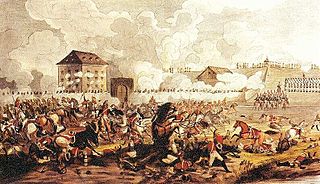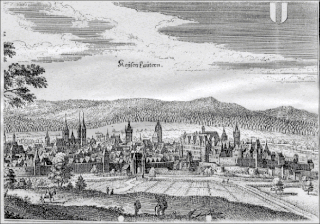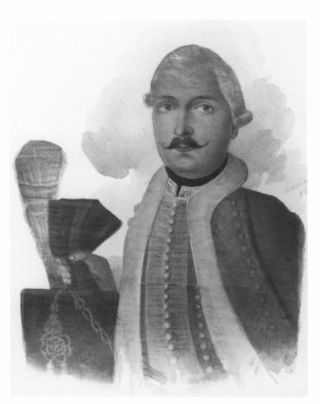
Jean-Charles Pichegru was a French general of the Revolutionary Wars. Under his command, French troops overran Belgium and the Netherlands before fighting on the Rhine front. His royalist positions led to his loss of power and imprisonment in Cayenne, French Guiana during the Coup of 18 Fructidor in 1797. After escaping into exile in London and joining the staff of Alexander Korsakov, he returned to France and planned the Pichegru Conspiracy to remove Napoleon from power, which led to his arrest and death. Despite his defection, his surname is one of the names inscribed under the Arc de Triomphe, on Column 3.

Dagobert Sigismund, Count von Wurmser was an Austrian field marshal during the French Revolutionary Wars. Although he fought in the Seven Years' War, the War of the Bavarian Succession, and mounted several successful campaigns in the Rhineland in the initial years of the French Revolutionary Wars, he is probably most remembered for his unsuccessful operations against Napoleon Bonaparte during the 1796 campaign in Italy.

The Battle of Raab or Battle of Győr was fought on 14 June 1809 during the Napoleonic Wars, between Franco-Italian forces and Habsburg forces. The battle was fought near Győr (Raab), Kingdom of Hungary, and ended in a Franco-Italian victory. The victory prevented Archduke John of Austria from bringing any significant force to the Battle of Wagram, while Prince Eugène de Beauharnais's force was able to link up with Emperor Napoleon at Vienna in time to fight at Wagram. Napoleon referred to the battle as "a granddaughter of Marengo and Friedland", as it fell on the anniversary of those two battles.

The Battle of Kaiserslautern saw a Coalition army under Charles William Ferdinand, Duke of Brunswick-Wolfenbüttel oppose a Republican French army led by Lazare Hoche. Three days of conflict resulted in a victory by the Prussians and their Electoral Saxon allies as they turned back repeated French attacks. The War of the First Coalition combat was fought near the city of Kaiserslautern in the modern-day state of Rhineland-Palatinate, Germany, which is located about 60 kilometres (37 mi) west of Mannheim.

The Second Battle of Wissembourg from 26 December 1793 to 29 December 1793 saw an army of the First French Republic under General Lazare Hoche fight a series of clashes against an army of Austrians, Prussians, Bavarians, and Hessians led by General Dagobert Sigmund von Wurmser. There were significant actions at Wœrth on 22 December and Geisberg on 26 and 27 December. In the end, the French forced their opponents to withdraw to the east bank of the Rhine River. The action occurred during the War of the First Coalition phase of the French Revolutionary Wars.

The Battle of Lonato was fought on 3 and 4 August 1796 between the French Army of Italy under General Napoleon Bonaparte and a corps-sized Austrian column led by Lieutenant General Peter Quasdanovich. A week of hard-fought actions that began on 29 July and ended on 4 August resulted in the retreat of Quasdanovich's badly mauled force. The elimination of Quasdanovich's threat allowed Bonaparte to concentrate against and defeat the main Austrian army at the Battle of Castiglione on 5 August. Lonato del Garda is located near the SP 668 highway and the Brescia-Padua section of Autostrada A4 to the southwest of Lake Garda.

Johann Mészáros von Szoboszló joined the Habsburg army in 1756 and fought the Prussians, Ottoman Turks, and French during a long military career. During the French Revolutionary Wars, he fought in several campaigns. He commanded a division in the 1796-1797 Italian campaign against the army of Napoleon Bonaparte. He was Proprietor (Inhaber) of an Austrian Uhlan regiment from 1792 to 1797 and a Hussar regiment from 1797 to 1801.
Adam Bajalics von Bajaháza, also Adam Bajalić von Bajaházy or Adam Bayalitsch, entered Austrian military service and fought against Prussia, Ottoman Turkey, and France. During the 1796–1797 Italian campaign against Napoleon Bonaparte, he commanded a brigade or a division in several actions.

In the Battle of Castiglione on 5 August 1796, the French Army of Italy under the command of General Napoleon Bonaparte defeated an Austrian army led by Field Marshal Dagobert Sigmund von Wurmser. Castiglione and the Battle of Lonato were the major actions in a campaign which marked the first attempted relief of the Siege of Mantua. While Wurmser advanced east of Lake Garda with three columns, Peter Quasdanovich moved his column into the area west of Lake Garda. The Austrians pushed back the French forces and forced Bonaparte to raise the siege. However, the French commander massed against Quasdanovich and forced him to retreat after a week of see-saw fighting. After disposing of Quasdanovich, Bonaparte turned on Wurmser and defeated the main army also. In the sequel, the French pushed the Mantua garrison back and blockaded the city.
In the Battle of Rivoli on 14 and 15 January 1797, the French Army of Italy led by Napoleon Bonaparte crushed the main Austrian army led by Jozsef Alvinczi. The battle occurred during the fourth Austrian attempt to relieve the Siege of Mantua. After crippling Alvinczi's army on the 14th, Bonaparte left Barthélemy Joubert and Gabriel Rey to finish off the Austrians and raced south with André Masséna to deal with a relief column led by Giovanni di Provera. On 16 January, Masséna, Pierre Augereau, and Jean Sérurier trapped Provera near the Mantua siege lines and forced his surrender.

Anton Ferdinand Freiherr Mittrowsky von Mittrowitz und Nemyšl, or Anton Mittrowsky, was promoted to general officer in the spring of 1796, just in time to lead a brigade against Napoleon Bonaparte during the 1796–1797 Italian Campaign in the War of the First Coalition. He served as a regimental commander in 1792–1796, leading his unit at Neerwinden, Famars, and Le Quesnoy in 1793. In the following year, he led the regiment at Landrecies, Beaumont, Courtrai, and Fleurus. In 1796, he led a brigade at Castiglione and 2nd Bassano, and played a pivotal role at Arcole, nearly defeating Bonaparte. In 1799, he commanded troops at Verona, Magnano, Novi, and Genola. During the Napoleonic Wars he led forces at Caldiero in 1805. He became the Proprietor (Inhaber) of an Austrian infantry regiment from 1806 until his death three years later.

Gerhard Ritter von Rosselmini or Gherardo Rosselmini or Gerhard Roselmini became a general officer in the Austrian army during the French Revolutionary Wars and fought in several actions against Napoleon Bonaparte's French army during the 1796 Italian campaign. From 1789 to 1794 he commanded an Austrian infantry regiment. He led the unit in several battles on the upper Rhine in 1793 before being captured. He was promoted to General Major in early 1794. Rosselmini died in Italy while on campaign.
Karl Philipp Sebottendorf van der Rose enrolled in the Austrian army at the age of 18, became a general officer during the French Revolutionary Wars, and commanded a division against Napoleon Bonaparte in several notable battles during the Italian campaign of 1796.

Count Ignác Gyulay de Marosnémeti et Nádaska, Ignácz Gyulay, Ignaz Gyulai was a Hungarian military officer, joined the army of the Habsburg monarchy, fought against Ottoman Turkey, and became a general officer during the French Revolutionary Wars. From 1806 he held the title of Ban of Croatia. In the struggle against the First French Empire during Napoleonic Wars, he commanded army corps. At the time of his death, he presided over the Hofkriegsrat, the Austrian Council of War.
The Battle of Handschuhsheim or Battle of Heidelberg saw an 8,000-man force from Habsburg Austria under Peter Vitus von Quosdanovich face 12,000 men from the Republican French army led by Georges Joseph Dufour. Thanks to a devastating cavalry charge, the Austrians routed the French with disproportionate losses. The fight occurred during the War of the First Coalition, part of the French Revolutionary Wars. Handschuhsheim is now a district of Heidelberg, but it was a village north of the city in 1795.
At the Battle of Höchst, the Habsburg Austrian army commanded by François Sébastien Charles Joseph de Croix, Count of Clerfayt outmaneuvered the French Republican Army of Sambre-et-Meuse commanded by Jean-Baptiste Jourdan. Although the French attacked first, they were unable to dislodge an Austrian flanking column. Afterward Jourdan's army retreated to the north. The clash happened during the War of the First Coalition, part of a wider conflict known as the French Revolutionary Wars. Modern-day Höchst is a suburb and administrative district of Frankfurt am Main in the state of Hesse in Germany. Höchst is about 12 kilometers (7 mi) west of the Frankfurt city center.
The Battle of Haguenau saw a Republican French army commanded by Jean-Charles Pichegru mount a persistent offensive against a Coalition army under Dagobert Sigmund von Wurmser during the War of the First Coalition. In late November, Wurmser pulled back from his defenses behind the Zorn River and assumed a new position along the Moder River at Haguenau. After continuous fighting, Wurmser finally withdrew to the Lauter River after his western flank was turned in the Battle of Froeschwiller on 22 December. Haguenau is a city in Bas-Rhin department of France, located 29 kilometres (18 mi) north of Strasbourg.

The siege of Landau saw a corps from the Kingdom of Prussia commanded by Frederick Louis, Prince of Hohenlohe-Ingelfingen lay siege to a 3,800-man French Republican garrison led by Joseph Marie Tennet de Laubadère. Since the Prussians lacked siege cannons, they tried to starve the French defenders into surrender by blockading the city. In late December, the French Army of the Moselle under Lazare Hoche and Army of the Rhine under Jean-Charles Pichegru defeated the Coalition armies opposed to them, forcing the Prussians to raise the War of the First Coalition siege.
Paul-Alexis Dubois commanded French divisions during the War of the First Coalition and was killed in action fighting against Habsburg Austria. He enlisted in a French infantry regiment in 1770 and transferred into the cavalry in 1776. Thereafter he served in several different cavalry and infantry regiments. From sous-lieutenant in 1791, he served in the Army of the Moselle and was rapidly promoted to general of brigade by August 1793. After briefly commanding an infantry division in the Army of the Rhine at Wissembourg he switched back to the Army of the Moselle to fight at Kaiserslautern before being wounded at Froeschwiller in December 1793.

This is the order of battle for the Battle of Tourcoing which was fought on 17–18 May 1794 between the First French Republic and the First Coalition.















